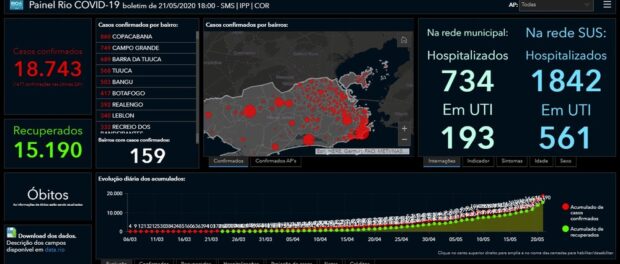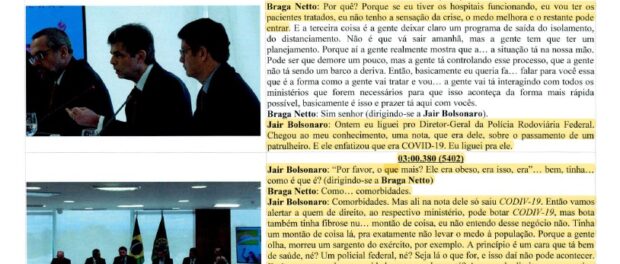
This is our latest article on the new coronavirus as it impacts Rio de Janeiro’s favelas.
Covid-19 death figures disappeared from the City of Rio’s official Covid-19 Monitoring Dashboard for four days between May 22-26 before returning at a level 40% lower than that calculated by Rio hospitals. The new figure, 1,801, creates a disparity of 1,177 deaths in relation to State Government data on its capital city: 2,978.
When the figure first disappeared, Mayor Marcelo Crivella told a press conference that the blackout had occurred due to a shift in death classification methods. “We are establishing criteria for verifying the cause of death so that [the process] is rigorous,” said the mayor.
The new criteria, according to O Globo, require victims’ death certificates—as collected from Rio cemeteries—to contain tested confirmations of coronavirus infection. Since death certificates are often published before results of Covid-19 tests are made available, families of infected victims will have to take it upon themselves to visit a notary office to rectify the cause of death with the City government. Few are expected to go to the trouble.
The City’s new reporting methods will also cease to separate the number of Covid-19 deaths by neighborhood, compromising the widespread efforts underway by community-based groups at prevention and mitigation.
In Line with the President
The changes took place after Crivella met with President Jair Bolsonaro, in Brasilia. At the start of the pandemic, the mayor’s office had shown itself to be aligned with Rio Governor Wilson Witzel in opting to impose restrictive measures to combat the Covid-19 pandemic in Rio de Janeiro.
However, following the meeting with President Bolsonaro on May 21, Crivella told reporters outside the Presidential Palace that he was looking to reopen businesses. “Tomorrow I am submitting, to my scientific council, the whole plan that I developed with business executives from all sectors that have been left at a standstill.” On the same day, the Rio Covid-19 Monitoring Dashboard stopped registering deaths from the pandemic in Rio de Janeiro.
In a ministerial meeting on April 22, of which a video was sent to the press in its entirety with the approval of Supreme Court Justice José Celso de Mello, Bolsonaro openly asked ministers and other members of the government to highlight the comorbidities—underlying health conditions—of people dying from Covid-19 as opposed to only counting them as deaths from coronavirus.
For the president, this “detail” in the disclosure of the information will make a difference in the population’s feelings of safety and fear concerning the coronavirus pandemic, which has already killed more than 24,000 Brazilians. With the decrease in fear, the government would send an image of having control over the health crisis, pressing state and municipal governments to end quarantine measures and resume economic activity.
During the meeting, soon after a brief speech by then-Health Minister Nelson Teich, Bolsonaro spoke of a call he had made to then-Director General of the Federal Highway Police (PRF) Adriano Marcos Furtado, as shown in the meeting’s transcript (see report No. 1242/2020 of the National Institute of Forensics of the Federal Police). The following dialogue is from page 33:
Bolsonaro: “It came to my knowledge, a note, which was from him [Director-General of the Federal Highway Police], about the passing away of a patrol officer. And he emphasized that it was Covid-19. I called him. ‘Please, what more? He was obese, was that it, was it?’ … Well, he had, whats that thing called?”
Chief of Staff Walter Braga Netto, responds: “Like… Comorbidities.”
Bolsonaro, then, concludes: “Comorbidities. But there on his official note was only listed Covid-19. So we are going to alert whoever has the right, the respective ministry, that they can put down Covid-19, but [they should] also put down that they had fibrosis… loads of things, I don’t understand this business. There were loads of things there, exactly so as not to scare the population. Because we see, an army sergeant died for example. Initially he is a healthy guy, right? A federal policeman, right? Whatever he is, and that there can’t happen. Se we are asking you to take this care with your colleagues, right? Whoever has the right, the respective ministry, which has someone in charge of this, right? To take this due care to not scare the population even more.”
According to O Globo, in Mayor Marcello Crivella’s announcement to the press on May 22, the mayor justified the removal of the death count from the Rio de Janeiro Covid-19 Monitoring Dashboard with the example of an elderly patient, being treated for cancer, who contracts coronavirus in the hospital and dies. “The doctors disagree whether he died with or from Covid-19,” said the mayor.
Rio de Janeiro’s Covid-19 Monitoring Dashboard then began to show only information about confirmed cases of coronavirus infection in the capital. The population thus lost access to data about the spread of deaths from the virus, in each neighborhood and the day on which they were registered.
As reported by the newspaper O Globo, the monitoring dashboard had already undergone previous modifications. However, on the other occasions, the alterations were highlighted in a section on the portal, noting “records of adaptations made on March 30 and 31 and after on April and 15 and May 15,” reporting the basis for each modification made. The exclusion of data about the death count was neither mentioned nor justified.
Crivella said only, in a collective interview reported by G1: “we are looking for information with other municipal governments and the Ministry for Health in order to update” the dashboard.
Other Data Sources
Conversely, on May 22, the State Health Secretariat published a new evaluation of the cases and deaths from the new coronavirus in Rio de Janeiro, revealing that the state had a record number of deaths in 24 hours and that the City of Rio had already counted 2,520 on May 19. Days later, on May 26 when the City relaunched its figures, declaring the number of deaths now at 1,801, the State government’s numbers for Rio had risen to 2,978.
Owing to the instability of the data made available by the municipal government, the favela-based newspaper Voz das Comunidades, which produces the Covid-19 in Favelas Dashboard, had already begun cross-checking the records of deaths and confirmed cases. On April 10, the outlet began comparing data from the City Monitoring Dashboard with data from the State Government of Rio de Janeiro and from the Family Health Clinics in favelas to which the newspaper has access.
According to the Covid-19 in Favelas Dashboard, on May 26, 871 infected residents and 203 deaths were registered in Rio de Janeiro’s favelas. According to Voz das Comunidades‘ survey, 29 new cases were confirmed in Rio de Janeiro’s favelas and there was one death in the last 24 hours. The death they registered today comes from Rocinha’s Family Clinic.
In a survey by RioOnWatch on May 13, using the dashboards developed by favela groups, hospitals, and through our own networks, we reported that at least 31 favelas registered Covid-19 cases, many of which had gone unreported by the City’s Covid-19 Monitoring Dashboard. Since then, we have already confirmed three more communities in Jacarepaguá (Monte Castelo, Francisco de Assis, and the community Antiga Creche in Colônia Juliano Moreira), for a total of 34 impacted communities.
Relaxation of Preventative Measures in Rio de Janeiro
The mayor announced on May 25 that he will publish a decree establishing measures for the reopening and running of temples and churches. While the City Monitoring Dashboard distorts the number of deaths from Covid-19 with the pretext of having revised its methodology, Crivella now looks to relax measures such as physical distancing.
According to O Globo the president of the Regional Council of Medicine of the State of Rio de Janeiro (Cremerj), Sylvio Provenzano, and professor of the Federal University of Rio de Janeiro (UFRJ), Celso Ramos, explained that the City’s Scientific Committee, convened by the municipal government itself, recommended continuing the prohibition of events that draw crowds and that the decree contradicted the committee, surprising the committee’s own members.


